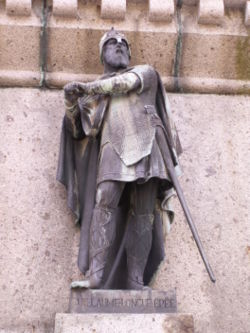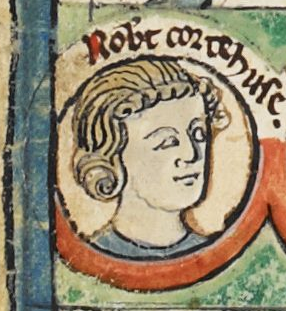 |
| Rollon of Normandy @Wikipedia |
(d. c846/860-c930)
Count of the Normans
911-932
Comte de Rouen
Founder of the
Duchy of Normandy
 |
| Poppa of Bayeaux @Wikipedia |
Her lover was:
"In a few words, the mother of William Longsword is very precisely located. Rollo, wrote Dudo, 'took with him for his pleasure a certain Poppa, a virgin, beautiful, born of a glorious blood, daughter of the prince Berenger; he bound himself to her by marriage and had by her a son named William.' She was a Frank, she was a Christian and there had been a marriage connubium. . . ." (Duby: 70)
Personal & Family Background: Papia was the daughter of Berenger, Count of Bayeaux, was taken as Rollo of Normandy's mistress and became the mother of William Longsword, second Duke of Normandy. (Duncan: 14)
Spouse & Children: " . . . On the death of Gisele, Rollo married his mistress, Papia, and declared the child he had by her, afterwards called William Longsword, his heir and successor. (Duncan: 22).
" . . . He married Poppa. All that is known of Poppa is that she was a Christian, and the daughter to Berengar of Rennes, the previous lord of Britannia Nova, which eventually became western Normandy." (Wikipedia)
Natural Children: "In his Gesta Normannorum Dudo skirts this issue and simply alludes to Poppa as the mother of Rollo's son William. There is no mention of the nature of this relationship, although the implication is that Poppa is simply a concubine. William of Jumiees adds the legitimising element in his Gesta Normannorum Ducum, and he identifies Poppa as the daughter of a distinguished man called Berengar. It is while on a rampage around Bayeux that Rollo takes up with her and shortly afterwards is 'bound' to her in accordance with these unspecified Danish customs." (O'Brien)
 |
| William I of Normandy Longsword @Wikipedia |
(893-942)
Comte de Rouen
927-942
Son of Rollon de Normandie & Poppa de Bayeaux
Husband of Luitgarde de Vermandois (914-978), daughter of Herbert II of Vermandois & Adele de France.
His lover was:
(1000-1035)
His lover was:
Herleva of Falaise (c1003-c1050).
"A beautiful woman of Falaise, daughter of a tanner. She was seen, standing at her door, by Robert, duke of Normandy, as he passed through the street; and he made her his mistress. She had by him William the Conqueror, who was born in 1044. After Robert's death, she married, Herluin, a Norman gentleman, by whom she had three children, for whom William honourably provided." (Adams: 66)
" . . . Herleva was no casual mistress of Duke Robert's; theirs was a long and stable relationship, it was simply that they never went through a formal wedding ceremony. The problem with Herleva was that she was low-born, the daughter of a tanner, and thus not a suitable wife for a Norman duke. . . ." (Given-Wilson and Curteis: 58)
" . . . As the valour and generosity of this duke influenced him to a firm and decisive conduct, so was his love as ardent. Passing through the city of Falaise, he chanced to see a rustic, distinguished for her beauty, dancing with her companions. Robert was so enamoured of her pleasing feature and superior grace, that she became his mistress and so continued ultil his departure for the Holy Land. Her name was Arlette, from which, if we may give credence to the old Chroniclers, is derived our English word, harlot. . . ." (Fisher: 56)
Personal & Family Background: " . . . William was a bastard: 'he was born of a concubine of Duke Robert called Herleva, daughter of his chamberlain, Fulbert.' So she was the daughter not of a tanner but of a household servant. Herleva was one of those girls born of servants and raised in the master's household from whom the latter chose his mistresses. The father of her son never took her as his wife. . . ." (Duby: 82)
Spouse & Children: " . . . This Arlette, who was daughter of Fulbert de Croy, skinner of Falaise, was married in duke Robert's life-time to Harlowen, son of John, surnamed de Burgo, earl of Comyn; her brother was John de Croy, afterwards called de Grey, progenitor of Henry de Grey, duke of Kent, etc. She in fact appears to have had two husbands, Gilbert, count of Brionne and Herlain, a Norman gentleman, who probably was her first. . . ." (Fisher: 56)
" . . . Orderic tells us, lastly, that Herleva, after the death of Duke Robert, was taken, this time as legitimate wife, by a knight of good birth, Herluin, to whom she gave two sons, 'Odo and Robert, later very famous'. . . ." (Duby: 82)
 |
| Robert Curthose Duke of Normandy |
Son of William the Conqueror of England and Matilda of Flanders.
Husband of Sibylla di Conversano, daughter of Geoffrey of Brindisi, Conte di Conversano.
His lover was:
Agnes a capable woman.
"In recording the death of Duchess Sibyl, Orderic also noted that deaths of several Norman magnates, including William of Breteuil, Ralph of Conches and Walter Giffard. The body of Walter Giffard was returned to Normandy and buried at the church of St. Mary at Longueville-sur-Scie, the caput of the family's Norman lands. Walter Gifards widow, Agnes, was the sister of Anselm of Ribemont the deceased crusader. Agnes was a capable woman and administered her husband's estates until her son, Walter, attained his majority. The widow 'burning with woman lust' had, however developed an infatuation for Duke Robert and had 'bound him to herself in the artful snares of illicit passion'. (Robert `Curthose', Duke of Normandy: 213)
"In recording the death of Duchess Sibyl, Orderic also noted that deaths of several Norman magnates, including William of Breteuil, Ralph of Conches and Walter Giffard. The body of Walter Giffard was returned to Normandy and buried at the church of St. Mary at Longueville-sur-Scie, the caput of the family's Norman lands. Walter Gifards widow, Agnes, was the sister of Anselm of Ribemont the deceased crusader. Agnes was a capable woman and administered her husband's estates until her son, Walter, attained his majority. The widow 'burning with woman lust' had, however developed an infatuation for Duke Robert and had 'bound him to herself in the artful snares of illicit passion'. (Robert `Curthose', Duke of Normandy: 213)
"Agnes de Ribemont, as the widow of Walter Giffard, was reputed to be the mistress of Robert Curthose. It remains unclear if or when she and Curthose even had an affair, but the story goes that she promised that if he would marry her he'd have the support of her powerful family. William of Malmesbury loved a good story, even if untrue, and in one version of his Gesta Regum he credits Sybilla's death to Robert's 'mistress' and in a later version he stated 'mid-wife.' However plausible it may have been that she was Robert's mistress, it remains less than plausible that Curthose allowed his new wife, Sybilla, the mother of his infant son to be poisoned while he sat idly by. Orderic Vitalis may have seen such a story just as further evidence Robert Curthose was unfit to rule Normandy. The mysterious story also has a chronological problem in that Agnes de Ribemont may not even have been a widow at the time of Sybilla's death, and if so, not free to marry." (Wikipedia)
"The Countess Agnes de Ribemont Giffard was the mistress of Robert Curthose Duke of Normandy. Agnes bore William Lord of Tortosa to the Duke. Guillaume de Jumièges records that Duke Robert Courtethuese married "Sibylle sœur de Guillaume comte de Conversano"[269]. Orderic Vitalis records that Sibylle (the legal wife of the Duke) was poisoned and died "during Lent"[271]. (According to William of Malmesbury, she died "by disease"[272].) Others said she died in childbirth. However, Orderic Vitalis alleges that Countess Agnes de Ribemont, widow of Walter Giffard Earl of Buckingham, fell in love with Duke Robert, had a son by him, and states that he believed Agnes poisoned Robert's wife Sibylle, although he does not directly attribute blame for her murder[273] Both Robert of Torigny and Orderic Vitalis suggest Sibylle was actually murdered by a cabal of noblewomen who were in favor of the Duke's mistress, the widow Countess Agnes Giffard. After Sybylle died, the marriage between Sibylle and Duke Robert was annulled posthumously." (geni.com)
"One noteworthy aspect of the Breteuil inheritance dispute is the absence of Robert Curthose from the conflict. His invisibility is typical of his very casual rule over Normandy and may also have been occasioned by the absorbing events that were then occurring in Curthose's personal life. On 25 October 1102 his duchess, Sibylla of Conversano, gave birth to his first and only legitimate son, William 'Clito.' Sibylla was much admired by the writers of her time, who praised her for her beauty and intelligence. Robert de Torigny observed that when she administered Normandy during Curthose's absences, she did more so successfully than her husband had done. But not long after giving birth to William Clito, Sibylla died---of an illness, so William of Malmesbury reports, brought on by a midwife mistakenly binding her breasts too tightly, or as Robert of Torigny remarks, more darkly, 'by a jealous cabal of some noblewomen.' Orderic, who similarly admired Sibylla, quotes the epitaph on her tomb at the cathedral de Rouen, which implies that she died on 18 March 1103. He tells of the adulterous relationship between Robert Curthose and Agnes Giffard, widow of Walter II Giffard (who died on 15 July 1102), explaining that Agnes, hoping to marry Duke Robert and rule Normandy for him, arranged to have the Duchess Sibylla poisoned. But Normandy was by then lapsing into such state of anarchy that Curthose, as Orderic explains, simply did not have the time of opportunity to marry Agnes.' Whatever the actual circumstances of Sibyllla's death may have been, the absence of her counsel seems to have left Normandy more hopelessly adrift than ever."
" . . . Orderic tells of a beautiful concubine of an old priest who became the mistress of Robert Curthose during his youthful wanderings and who, unbeknownst to him, bore him two sons. How Robert could have overlooked these births is difficult to fathom (although he is known to have been a singularly inattentive person), but Orderic assures us that he did. Many years thereafter, when the sons were grown, their mother presented them to Duke Robert and requested that he accord them recognition. Robert was suspicious of her claim at first and demanded that she prove it by the ordeal of the hot iron. Once she had done so, he conferred recognition to them and took them under his protection." (Hollister. Henry I: 44)
Natural children (with unknown mistresses):
a. Richard (d.1100)
b. William, Lord of Tortosa (d.after 1110)
c. Daughter married Helias de Saint-Saens.